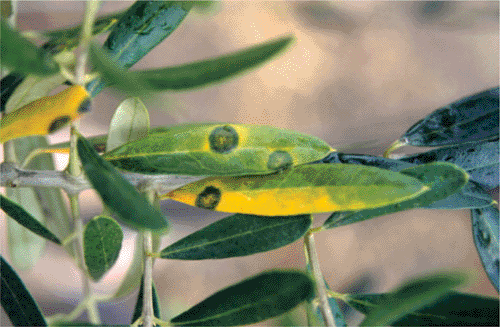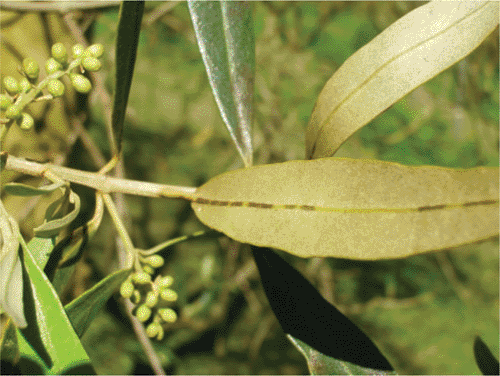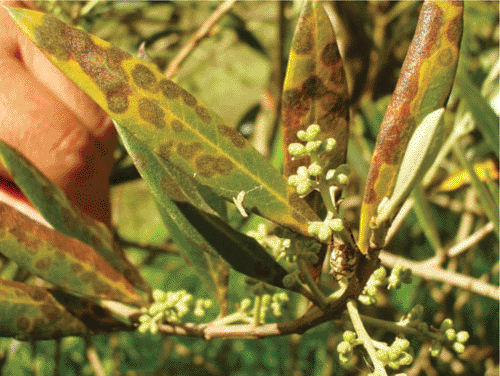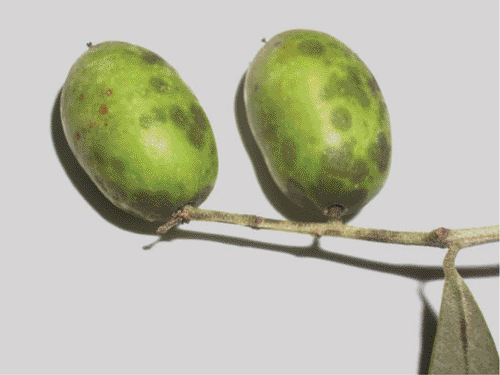Observations on spot caused by Fusicladium oleagineum on olives (Olea europaea) in New South Wales, Australia
V. Sergeeva A C , U. Braun B , R. Spooner-Hart A and N. G. Nair AA Centre for Plant and Food Science, University of Western Sydney, Locked Bag, 1797, Penrith South DC, NSW 1797, Australia.
B Martin-Luther-Universität, FB. Biologie, Institut für Geobotanik und Botanischer Garten, Herbarium, Neuwerk 21 D-06099 Halle/S, Germany.
C Corresponding author. Email: v.sergeeva@uws.edu.au
Australasian Plant Disease Notes 4(1) 26-28 https://doi.org/10.1071/DN09011
Submitted: 9 January 2009 Accepted: 9 March 2009 Published: 23 March 2009
Abstract
The first record of peacock spot on olives in New South Wales, Australia, was made informally in 1947 but no herbarium specimen was deposited nor descriptions made. Subsequent descriptions of this disease in Australia have been sketchy and generally reported in extension articles for olive growers. We provide here a consolidated report and description of the occurrence of Fusicladium oleagineum on the lamina, veins and petioles of leaves, fruits and pedicels of fruits of olives (Olea europaea) in New South Wales.
The name Cycloconium oleagineum Castagne = Spilocaea oleaginea (Castagne) S. Hughes has been commonly used for the causal organism of peacock spot disease of olives. However, it is currently assigned to the genus Fusicladium as F. oleagineum (Castagne) Ritschel & U. Braun (= Spilocaea oleaginea (Castagne) S. Hughes) by Schubert et al. (2003). We report F. oleagineum on O. europaea in New South Wales and provide a description of the disease.
Peacock spot is also known as olive scab and leaf spot and is widespread in all the major olive growing regions of the world (Obanor et al. 2005). Symptoms have been found to occur mainly on leaves and appear as dark green to black spots surrounded by a yellow halo similar to the eye spot on peacock’s feathers; hence, the name peacock spot (Graniti 1993; Shabi et al. 1994). Peacock spot is considered to be the most important olive grove disease in Spain (Trapero and Blanco 2008). Crop losses arise mostly from defoliation of infected trees, poor growth and dieback of defoliated branches and reduced fruit yield (Graniti 1993; Viruega et al. 1997). Heavy defoliation has been reported to cause a delay in ripening and a decrease in oil yield in Italy (Graniti 1993) and New Zealand (MacDonald et al. 2000).
The first record of the disease in Australia was in 1947 on leaves from New South Wales. However, a herbarium specimen was not deposited nor a description of the disease made (M. Priest, pers. comm.). The first herbarium specimen on diseased fruits is dated 1989, as Spilocaea (M. Priest, pers. comm.). Subsequent descriptions of the disease in Australia have mainly occurred as extension articles or field guides for growers (Spooner-Hart et al. 2007) and in reports on pests and diseases occurring on Australian olives (Spooner-Hart et al. 2002; Spooner-Hart 2005).
The disease is commonly found in many olive-growing regions in Australia (Spooner-Hart et al. 2002). Based on diagnoses from numerous samples collected from throughout Australia since 2002 at the University of Western Sydney (UWS), peacock spot occurs in the states of Victoria, South Australia and Queensland as well as the Australian Capital Territory. An outbreak of peacock spot was reported in Western Australia in 2006 (Sivyer 2006). It has not yet been recorded in Tasmania, probably due to its isolation from the Australian mainland.
The studies were conducted in several locations in NSW, in particular the Sydney Basin (UWS, Menangle) and the Hunter Valley, over a period of 6 years. An isolate of F. oleagineum from fruits of cv. Frantoio at University of Western Sydney, Richmond, NSW (33.599°S; 150.746°E) was deposited at the Herbarium of the Martin-Luther-University, as HAL 2225 F. However, the pathogen was also observed on cvv. FS-17, Barnea and Manzanillo in an olive grove at Menangle, NSW, (34.123°S; 150.743°E) on the lamina and tips of leaves, fruits and pedicels of fruit. From these observations it appears that outbreaks are sporadic, and the disease could take several years to become serious enough to cause crop loss. The fungus caused a range of symptoms on the upper and lower surfaces of leaves. During winter the disease appeared as sooty blotches on leaves. In spring the newly infected young leaves showed blotches covered with the fungal spores. These blotches developed into black circular spots that measured 2–10 mm in diameter, occasionally surrounded by a yellow halo. On yellow leaves, the spots appeared greenish-brown in colour. Yellow-greenish circular spots developed on the older leaves, and were most commonly seen on the upper surfaces (Fig. 1). Infection was detected on veins of the lower leaf surface (Fig. 2). Leaves of the lower branches of the trees were affected first.

|

|
Defoliation was another typical symptom observed, resulting in less shoot growth and poor bud formation. Most of the infected leaves appeared to fall prematurely in spring when the infection was high. It was also noted that high levels of infection on leaves before flowering (Fig. 3) resulted in flower drop and poor fruit set. Death of twigs was recorded, which further contributed to lower yield. Old infections on leaves became crusty and whitish following high temperatures. The results of this study showed that a high percentage of new leaves which developed after leaf drop were re-infected by F. oleagineum during warm and humid summers. Thus, peacock spot may be present all year round in olive groves, if conditions are suitable.

|
Fruits were also found to be infected by the fungus (Fig. 4). Spots carrying grey to black masses of spores were seen on fruits, and heavily infected fruits dropped. A much higher incidence of infection was observed in some cultivars such as Manzanillo, Barnea and F17 than in other, co-located cultivars (e.g. Frantoio). Infection of fruit pedicels also occurred on the former cultivars more frequently. Lesions appeared as small grey to black spots which enlarged, causing the pedicel to break and this resulted in fruit drop. The tips of branches carrying the fruits also showed greyish-black lesions. According to MacDonald et al. (2000), cvv. Barnea, Manzanillio, Frantoio, Leccino, Nabali and Souri are susceptible to peacock spot in New Zealand.

|
Heavily infected leaves and fruit were observed on the ground and, as well as on those that remained on the tree, could be a source of inoculum for the current season or allow over-wintering of the fungus. The pathogen is known generally to survive unfavourable conditions, e.g. dry, hot weather, in fallen leaves as well as in infected leaves on the tree. The conidia formed in leaves on the tree can survive for several months; although once they have separated from the conidiophores they lose their germination ability in less than a week (Viruega and Trapero 1999). Following a period of moist warm weather new batches of conidia are readily produced on the foliar spots. Viable conidia are also produced in fallen leaves. However, their role as inoculum to produce new infections is considered to be negligible (Trapero and Blanco 2008). This study has shown that the disease generally is favoured by cool weather; however, the warm and humid weather during the summer of 2009 was also observed to encouraged disease occurrence. These observations support those of Viruega and Trapero (1999), who found that in Spain leaf infections can remain latent over summer without causing any leaf drop and are the main source of inoculum for autumn–winter infection.
Observations also indicated that young leaves were very susceptible to infection in spring, and that foliage in lower parts of trees was more frequently infected. This is consistent with the pathogen’s requirement for high humidity to develop. Germination requires 98% humidity, with temperatures in the range of 0–27°C (Trapero Cassas 1994). In Australia the disease can be inactive during the hot and dry summers. Germination of the spores is restricted at temperatures above 30°C.
The observed symptoms and epidemiology, together with the widespread occurrence of peacock spot of olives caused by F. oleagineum, suggest that it has potential to be an important disease of olives in Australia.
Graniti A
(1993) Olive scab: a review. OEPP/EPPO Bulletin 23, 377–384.

MacDonald AJ,
Walter M,
Trought M,
Frampton CM, Burnip G
(2000) Survey of olive leaf spot in New Zealand. New Zealand Plant Protection 53, 126–132.

Obanor EO,
Walter M,
Jones EE, Jaspers MV
(2005) In vitro effects of fungicides on conidium germination of Spilocaea oleagina, the cause of olive leaf spot. New Zealand Plant Pathology 58, 278–282.
|
CAS |

Schubert K,
Ritschel A, Braun U
(2003) A monograph of Fusicladium s.lat. (Hyphomycetes). Schlechtendalia 9, 71–132.

Shabi E,
Birger R,
Lavee S, Klein I
(1994) Leaf spot (Spilocaea oleaginea) on olive in Israel and its control. Acta Horticulturae 356, 390–394.

Spooner-Hart R,
Tesoriero L,
Hall B,
Page F,
Learmonth S, Conlan D
(2002) Progress towards pest and disease management in Australian olive production. Advances in Horticultural Science 16, 218–224.

Trapero Cassas A
(1994) El repilo del olivo. Agricultura 746, 788–790.

Viruega JR,
Lique F, Trapero A
(1997) Caída de aceituhas debida a infectciones del pedunculo por Spilocaea oleagina, agente del Repilo del olivo. Fruticultura Profesional 88, 48–54.

Viruega JR, Trapero A
(1999) Epidemiology of leaf spot of olive tree caused by Spilocaea oleagina in southern Spain. Acta Horticulturae 474, 531–534.



